Agustin (and many others) have a hard time hopping on the bus
 On August 10, 2005, so many people were waiting for the bus at 11:40 pm, that seven people were left behind once the bus arrived. Washington Post photo by Gerald Martineau.
On August 10, 2005, so many people were waiting for the bus at 11:40 pm, that seven people were left behind once the bus arrived. Washington Post photo by Gerald Martineau.Today's Post has an important story by Lyndsay Layton about the Metrobus system, "Progress Has Passed Metrobus By: Outdated System Is Plagued by Unreliable Schedules, Inefficient Routes."
From the article:
As shifting housing patterns, job growth and an influx of residents have transformed metropolitan Washington over the past three decades, Metrobus has done little to adapt, remaining essentially the same system since opening in 1973. The nation's fifth-largest bus system still follows the basic contours of the D.C. streetcar lines of the 1950s.
Each day, 443,000 passengers -- many without options -- grapple with a transportation system of last resort. Buses are so unreliable, even Metro's chief executive has acknowledged that the schedules are fiction. Riders must transfer multiple times to reach their destinations. One bus line averages 84 passengers per trip, while another carries four.
A mismatch between demand and service has produced hidden rush hours, with standing room only on some buses at 11 on weeknights or 3 p.m. on weekends. Metrobus officials have not analyzed ridership on some weekday routes in three years. And it's been five years since they monitored passenger loads on weekend routes, Metro officials say.
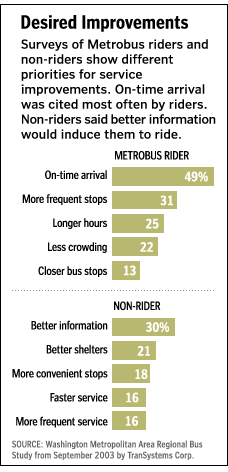 Washington Post graphic.
Washington Post graphic.It's a good article, but glosses over an important point. My understanding is that each jurisdiction contracts separately for Metrobus service. So the example of a bus route in Fairfax County being subsidized to the tune of almost $11 per passenger, if cancelled, wouldn't bring relief to an overcrowded bus on 16th Street NW, because DC contracts and pays for Metrobus service separately from Fairfax County.
It's been awhile since I've focused on this part of the DC Dept. of Transportation, which was once called the Mass Transit Administration. I think it's now the "Transportation and Policy and Planning Administration," but I don't know who the director is. This unit in large part responsible for improving Metrobus service on the part of the DC Government.
This isn't to let Metro/WMATA off the hook, I think they've proven that they aren't too in touch with "customer" needs. I didn't write about this aspect of it, but I went to the Metro Open House a month ago at the Reeves Center, and I made certain specific suggestions to a couple people, such as how the Downtown Circulator needs signficant wayfinding signage at Union Station to explain what it is and how to use it, and it was like I was talking to an automaton, someone trained to just give me lip service. It pissed me off, because I actually know a fair amount about this stuff, and frankly, if they can pay consultants for such advice (which they don't seem to be getting) they ought to be able to recognize quality information.
 MetroRapid signage in Los Angeles.
MetroRapid signage in Los Angeles.I have written quite a bit about bus service and marketing in a number of previous blog entries:
-- Metrobus Capital Improvement Program;
-- Bus shelters revisited;
-- The first priority for Bus shelters ought to be marketing transit;
-- Speaking of bus marketing part 2; and
-- about marketing buses with pizzazz as part of this entry.
Transportation planning is key. So is marketing. And you must know by now that the best marketers don't always end up working for government agencies... especially when urban planning programs often offer transportation planning courses only sporadically. (E.g., the University of Maryland hasn't offered their transportation planning class since 2002.) Such classes should be required for every student in such programs...
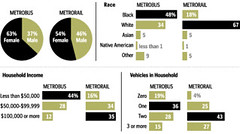 Transit rider demographics, Washington, DC region. Washington Post graphic.
Transit rider demographics, Washington, DC region. Washington Post graphic.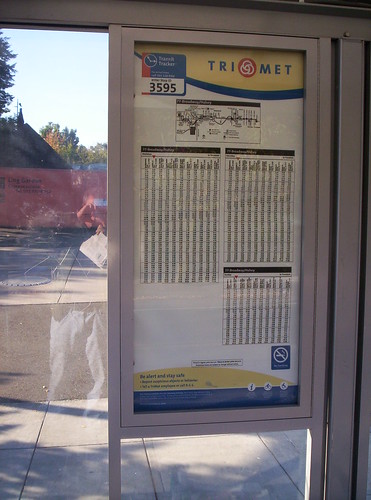 Bus schedules are posted inside most bus shelters in Portland Oregon.
Bus schedules are posted inside most bus shelters in Portland Oregon.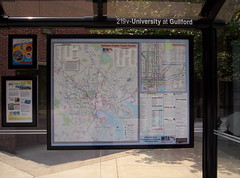 Bus Shelter on University Boulevard in Baltimore, with occasional newsletter to transit riders posted to the left of the map. This stop markets transit, even to non-riders, because of the high visibility of the materials within the shelter, and the high amount of foot traffic that passes by the shelter. (Now if only MTA had more frequent bus service...).
Bus Shelter on University Boulevard in Baltimore, with occasional newsletter to transit riders posted to the left of the map. This stop markets transit, even to non-riders, because of the high visibility of the materials within the shelter, and the high amount of foot traffic that passes by the shelter. (Now if only MTA had more frequent bus service...).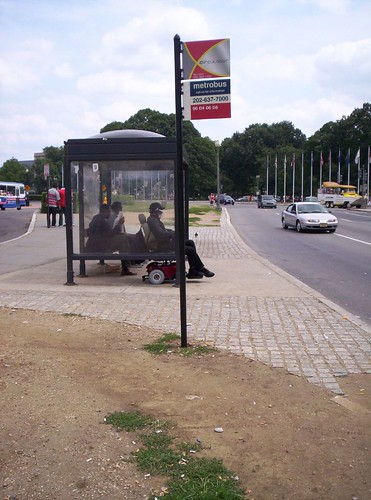 Neglected bus stop at Union Station, Washington, DC.
Neglected bus stop at Union Station, Washington, DC.Index Keywords: transit



0 Comments:
Post a Comment
<< Home